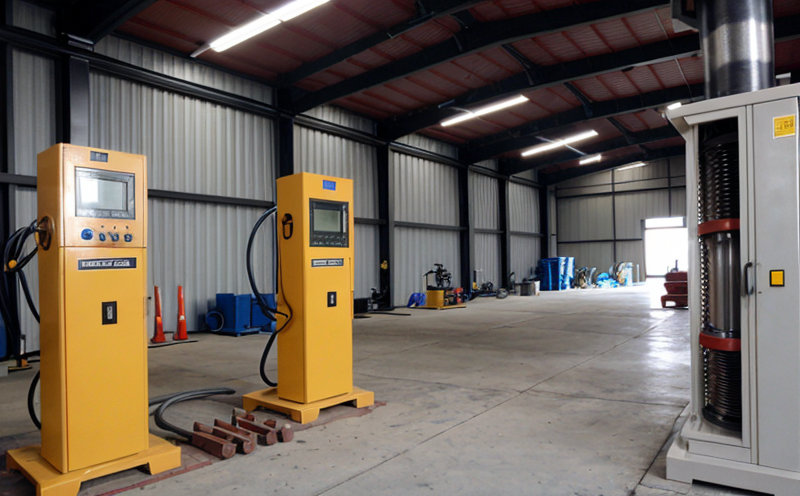Mechanical Strength & Compression Testing
In the realm of packaging testing, mechanical strength and compression testing are critical processes that ensure the integrity and durability of packaging materials under various stress conditions. This form of assessment is paramount in ensuring that packages can withstand the rigors of distribution, handling, and storage without compromising product safety or quality.
The mechanical properties of a package determine its ability to protect contents from external forces such as impact, pressure, and vibration. These tests are essential for both design verification and compliance with industry standards and regulations. By evaluating these attributes, manufacturers can optimize packaging efficiency and reduce material waste, thereby improving overall sustainability.
During mechanical strength and compression testing, samples undergo controlled loading to simulate real-world conditions such as stacking, dropping, or pressure from machines. This process helps identify potential weaknesses in design that might lead to product damage during transit. The results provide actionable insights for continuous improvement, ensuring that every package meets the highest standards of reliability.
Understanding the mechanical behavior of packaging materials is crucial for achieving robust designs that minimize risks while maintaining cost-effectiveness. This testing also aids in compliance with various international standards, including ISO 17859-2 for compression testing and ASTM D6428 for impact testing on rigid containers.
The scope of mechanical strength and compression testing includes the evaluation of various properties such as tensile strength, compressive yield point, flexural modulus, and ultimate elongation. These metrics are essential in selecting appropriate materials that offer adequate protection while being lightweight and cost-efficient.
To achieve accurate results, samples must be prepared according to specific protocols outlined by relevant standards. This involves cutting specimens from the packaging material using precise tools, ensuring uniformity across all test pieces. The choice of sample size is critical as it affects both the accuracy and reproducibility of the tests.
Instrumentation plays a pivotal role in mechanical strength and compression testing. High-precision machines equipped with sensors capable of measuring force, displacement, and strain provide real-time data during loading cycles. This information allows for detailed analysis and interpretation, leading to more informed decision-making processes within R&D teams.
The acceptance criteria for passing these tests vary depending on the type of packaging being evaluated but generally focus on meeting minimum specified values for key mechanical properties without failure. Compliance with these standards ensures that packages perform as expected throughout their lifecycle, enhancing customer satisfaction and brand reputation.
Applied Standards
| Standard | Description |
|---|---|
| ISO 17859-2 | Compression testing of rigid containers. |
| ASTM D6428 | Impact testing on rigid containers. |
Competitive Advantage and Market Impact
Evaluating the mechanical strength of packaging materials through compression tests offers several strategic advantages for businesses operating within this sector. By ensuring robust designs, companies can enhance their product offerings, thereby gaining competitive edge over rivals who may not invest in similar quality assurance measures.
Market leaders that prioritize mechanical testing demonstrate a commitment to excellence, which translates into increased trust and loyalty among consumers. Such organizations often see higher sales volumes due to satisfied customers recommending products based on superior packaging performance.
In addition, compliance with international standards like ISO 17859-2 and ASTM D6428 not only enhances brand reputation but also opens up opportunities for export into markets demanding stringent quality controls. This global recognition fosters long-term growth prospects by establishing a strong foothold in key geographical areas.
Moreover, investing in mechanical strength testing supports sustainability initiatives by minimizing waste through optimized material usage and reducing environmental impact associated with substandard packaging solutions. Companies adopting such practices contribute positively towards corporate social responsibility goals, attracting eco-conscious consumers who value environmentally friendly products.
Use Cases and Application Examples
| Use Case | Description |
|---|---|
| Distribution Logistics | Evaluating how packages handle stacking and pressure during transportation. |
| Automated Handling Machines | Testing resilience against repeated handling by machinery. |
In distribution logistics, mechanical strength tests are conducted to assess how packages behave under simulated stacking scenarios. This ensures that boxes or crates can withstand multiple layers without compromising their structural integrity. Such evaluations help prevent issues like collapse during shipment, ultimately reducing damage claims and improving customer satisfaction.
For automated handling machines used in manufacturing plants or warehouses, mechanical strength testing focuses on evaluating the resilience of packaging materials against repeated cycles of loading and unloading. This helps identify any potential wear patterns that could lead to premature failure, allowing for timely replacements before they become problematic.





